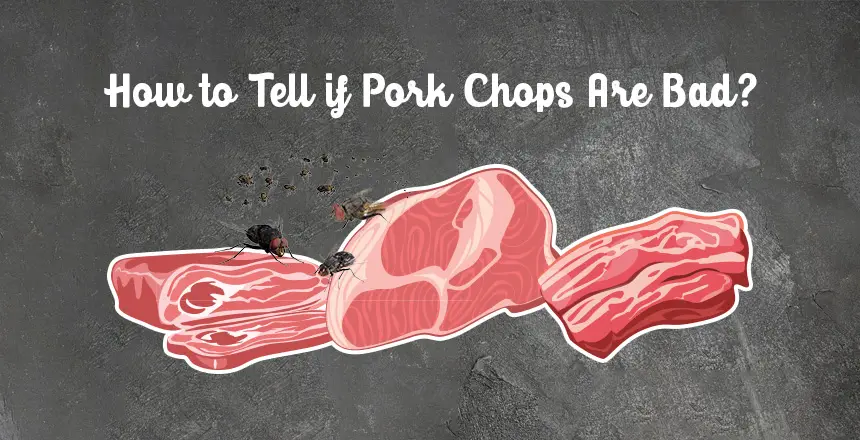Are you craving a delicious pork chop dinner?
Before you dive into that sizzling piece of meat, make sure you know the telltale signs of spoiled pork chops.
In this guide, we’ll unlock the secret to deciphering whether your pork is past its prime or ready to be cooked to perfection.
From color and marbling to storage tips and cooking temperatures, get ready to become an expert in identifying the freshness of your pork chops.
Let’s dig in!
how to tell if pork chops are bad
To determine if pork chops are bad, look for signs such as a change in color, foul odor, or slimy texture.
Fresh pork chops should have a light pink color with small amounts of fat around the outer edge and marbling of fat throughout for tenderness.
If the pork chops have turned grayish or brownish, that may indicate spoilage.
Additionally, a strong, unpleasant odor or a slimy texture are clear indicators that the pork chops have gone bad and should be discarded.
Proper storage in the refrigerator for no more than 3 to 5 days after purchase, or freezing before the “sell by” date, can help prevent spoilage and maintain the meat’s quality.
It is essential to cook pork chops to an internal temperature of 160 degrees Fahrenheit to ensure they are safe to eat.
Key Points:
- Look for signs of bad pork chops: change in color, foul odor, or slimy texture.
- Fresh pork chops should be light pink with small amounts of fat and marbling throughout.
- Grayish or brownish color may indicate spoilage.
- A strong, unpleasant odor or slimy texture mean the pork chops have gone bad.
- Proper storage in the refrigerator or freezing can help prevent spoilage.
- Cook pork chops to an internal temperature of 160 degrees Fahrenheit for safety.
how to tell if pork chops are bad – Watch Video
💡
Pro Tips:
1. Pork chops have a distinct odor when they go bad, often described as a sour or ammonia-like smell. Trust your nose! If it smells off, it’s best to discard them.
2. Did you know that the color of pork chops can also indicate their freshness? Fresh pork chops should have a pinkish-red color, while grayish or dull-colored chops may be a sign of spoilage.
3. While the expiration date on the packaging is a good reference point, it’s essential to note that pork chops can still spoil before that date if not stored properly. Always ensure they are kept refrigerated at or below 40°F (4°C).
4. Another way to determine if pork chops have gone bad is by checking their texture. If they feel slimy or excessively moist to the touch, it’s a strong indication that they have begun to spoil.
5. Freezing pork chops can extend their shelf life, but it’s essential to use them within a certain time frame. Frozen pork chops should be consumed within 4-6 months to ensure they are still safe to eat.
1. Fresh Pork Chops: Appearance And Texture
Fresh pork chops should exhibit specific characteristics to ensure their quality and safety for consumption. One of the primary indicators of freshness is the meat’s color. When purchasing fresh pork chops, they should appear light pink, indicating that they are in their prime condition. Additionally, look for small amounts of fat around the outer edge and marbling of fat throughout the meat for tenderness. This marbling not only adds flavor but also helps maintain moisture during cooking.
It is important to note that color can be subjective, and certain factors such as the specific cut of meat and the pig’s diet can affect the coloration. However, if you notice any discoloration, such as a grayish or greenish hue, it may indicate spoilage.
2. Refrigeration Timeline For Pork Chops
Proper storage of pork chops is vital to maintain their freshness and prevent the growth of harmful bacteria. After purchase, fresh pork chops should be promptly refrigerated. It is recommended to consume or cook them within 3 to 5 days to ensure optimal quality. This timeline allows for the enjoyment of pork chops at their peak flavor and tenderness.
To maximize the shelf life of fresh pork chops, store them in the coldest part of the refrigerator, ideally below 40 degrees Fahrenheit. Be sure to place the meat in a sealed container or wrap it tightly in plastic wrap to prevent cross-contamination with other foods.
- Store fresh pork chops in the coldest part of the refrigerator
- Keep the temperature below 40 degrees Fahrenheit
- Use a sealed container or tight plastic wrap to prevent cross-contamination
3. Extending Refrigeration After Cooking
If you have cooked pork chops and wish to prolong their shelf life, refrigeration is key. After cooking, the remaining pork chops can be safely refrigerated for an additional three days. Ensure that they have cooled down to room temperature before storing them in the refrigerator.
To maintain their freshness during refrigeration, it is crucial to store the cooked pork chops properly. Place them in an airtight container or wrap them tightly with aluminum foil. This will prevent any odors from other foods in the refrigerator from seeping into the pork and maintain its original flavor.
- Refrigerate cooked pork chops for up to three days.
- Allow them to cool down to room temperature before refrigeration.
- Store in an airtight container or wrap tightly with aluminum foil to maintain freshness.
4. Preventing Spoilage: Freezing Before “Sell By” Date
Freezing pork chops before the “sell by” date is an effective method to prevent spoilage and extend their shelf life. The “sell by” date is provided by the manufacturer to indicate when the meat should be sold by the retailer. As a consumer, freezing the pork chops before this date ensures that they remain safe for consumption when thawed.
By freezing the pork chops, you halt the growth of bacteria that can potentially cause foodborne illness. It is important to remember that freezing doesn’t destroy bacteria; it only inhibits their growth. Therefore, it is crucial to handle the meat safely before freezing to minimize the risk of contamination.
5. Best Practices For Freezing Pork Chops
To ensure the best quality when freezing pork chops, it is essential to follow a few guidelines. Firstly, package the individual pieces of meat properly. Wrap each pork chop tightly with plastic wrap or place them in airtight freezer bags to prevent freezer burn.
Additionally, labeling the frozen pork chops with the date of freezing can help you keep track of their storage duration. Freezing pork chops for longer than three months is not recommended, as the quality of the meat tends to deteriorate over time.
6. Ensure Safe Consumption: Proper Cooking Temperature
To prevent foodborne illnesses, it is vital to cook pork chops to the proper internal temperature. The United States Department of Agriculture (USDA) recommends cooking pork to an internal temperature of 160 degrees Fahrenheit (71 degrees Celsius). Using a food thermometer is the most accurate way to determine if the pork chops have reached the recommended temperature.
Cooking pork to the correct temperature ensures that potential parasites and bacteria, such as Salmonella and E. coli, are killed, making the meat safe for consumption. Undercooked pork can pose health risks, so it is crucial to adhere to these guidelines for everyone’s safety.
- Cook pork chops to an internal temperature of 160 degrees Fahrenheit (71 degrees Celsius)
- Use a food thermometer for accurate measurement
- Proper cooking kills parasites and bacteria, ensuring safety for consumption
“Cooking pork to the correct temperature is crucial for preventing foodborne illnesses.”
7. Signs Of Spoiled Pork Chops
It is essential to know the signs that indicate pork chops have gone bad to prevent any risks to your health. One of the first noticeable signs of spoilage is an off or foul smell. If the meat emits a strong, unpleasant odor, it is best to discard it immediately.
Another indicator of spoiled pork chops is a slimy texture or a sticky film on the surface of the meat. Any sliminess or stickiness suggests the presence of bacterial growth, making it unsafe for consumption. Additionally, any noticeable discoloration, such as a gray or green tinge, is a definite sign of spoilage and should be avoided.
8. The Importance Of Marbling For Tenderness
Marbling, which refers to the small streaks of fat dispersed throughout the meat, is an important factor to consider when purchasing pork chops. The presence of marbling greatly contributes to the tenderness and overall quality of the meat.
Why is marbling important? Well, the intramuscular fat found in marbling provides both moisture and flavor during the cooking process. This enhances the eating experience and results in a more enjoyable dish.
When selecting pork chops, it is advisable to prioritize cuts that exhibit marbling. This will guarantee a tender and flavorful outcome. However, it’s important to note that excessive fat lined around the edges of the meat may indicate a poor quality cut. Therefore, finding the right balance between marbling and fat content is key in achieving the ideal texture and taste when cooking pork chops.
To summarize:
- Marbling is the small streaks of fat dispersed throughout the meat.
- It plays a vital role in the tenderness and overall quality of pork chops.
- The intramuscular fat in marbling provides moisture and flavor during cooking.
- Prioritize cuts with marbling for a tender and flavorful dish.
- Excessive fat around the edges may indicate a poor quality cut.
- Balancing marbling and fat content is crucial for the ideal texture and taste.
“Balancing the marbling and fat content will ensure the ideal texture and taste when cooking pork chops.”
9. Storing Leftover Pork Chops
If you have leftover pork chops, proper storage is essential to maintain their quality and prevent any foodborne illnesses. Once you have enjoyed your meal, allow the pork chops to cool down to room temperature before storing them in the refrigerator.
To store leftover pork chops, place them in an airtight container or wrap them tightly with aluminum foil. This will ensure that no air or odors are in contact with the meat, preserving its flavor and preventing cross-contamination.
10. Recommended Cooking Methods For Pork Chops
Pork chops can be cooked in various ways to suit personal preferences and create unique flavors. Some of the most popular cooking methods for pork chops include grilling, baking, pan-frying, and broiling.
Grilling pork chops imparts a smoky flavor while maintaining their juiciness. Baking is a more hands-off method that allows you to infuse additional flavors by marinating the meat beforehand. Pan-frying offers the opportunity to achieve a crispy exterior, while broiling gives a deliciously caramelized crust.
Regardless of the cooking method, it is important to follow the recommended internal cooking temperature of 160 degrees Fahrenheit to ensure the pork chops are thoroughly cooked and safe to eat.
Understanding how to determine the freshness of pork chops and proper storage techniques is crucial for safe consumption. By paying attention to their appearance and texture, adhering to recommended refrigeration timelines, and following proper freezing and cooking practices, you can enjoy delicious pork chops while mitigating the risk of foodborne illnesses. Remember to trust your senses and discard any spoiled pork chops to prioritize your health and well-being.
💡
You may need to know these questions about how to tell if pork chops are bad
What do bad pork chops smell like?
Bad pork chops that have turned bad may emit a foul odor, distinct from their usual fresh, meaty smell. When spoiled, the pork chops may release a scent that is reminiscent of sourness or ammonia. These pungent aromas are distinct signals that the meat has gone bad and should be promptly discarded to avoid any potential health risks. In addition to the smell, one should also be cautious if the packaging appears puffed-up or bloated, as this could be an indication of bad bacteria producing gases within the packaging.
How long do pork chops last in the fridge?
When it comes to storing pork chops in the fridge, it is best to consume them within 3-5 days to ensure freshness and taste. To maximize their shelf life, it is crucial to store them in an airtight container or wrap them tightly in aluminum foil or plastic wrap. By following these storage tips, you can ensure that your pork chops retain their quality and are ready to use in a variety of delicious recipes.
When should you not eat pork chops?
It is crucial to avoid consuming undercooked or raw pork chops to prevent the risk of parasitic infections. Specifically, pork tapeworm (Taenia solium) is a notable concern, as it can cause a condition known as cysticercosis. Although most individuals experience no symptoms, cysticercosis can lead to the development of epilepsy in certain cases. Thus, it is advisable to ensure that pork chops are thoroughly cooked to eliminate any potential parasites and minimize the risk of associated health complications.
Are pork chops good after 7 days in fridge?
Pork chops are best consumed within 3 to 5 days when stored properly in the refrigerator. However, after 7 days, it is recommended to exercise caution and assess the quality of the pork chops before consuming. While refrigeration helps slow down the growth of bacteria, it does not completely halt it. Therefore, it is advisable to trust your senses, such as smell and appearance, to determine if the pork chops are still safe to eat after a week in the fridge. Better safe than sorry when it comes to food safety.
Reference source
https://www.ehow.com/how_8387978_pork-chops-gone-bad.html
https://www.youtube.com/watch?v=oomojTheW5Y
https://www.tastingtable.com/829436/warning-signs-your-pork-has-gone-bad/
https://shutterandmint.com/how-long-do-pork-chops-last-in-the-fridge/



